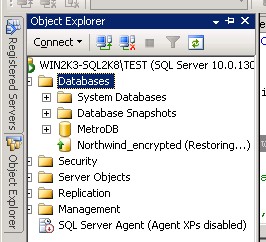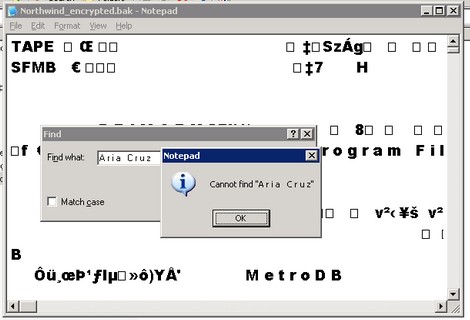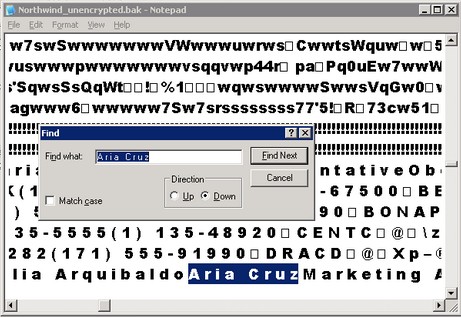What is TDE (Transparent Data Encryption) in SQL 2008?
Ref:
https://www.mssqltips.com/sqlservertip/1514/sql-server-2008-transparent-data-encryption-getting-started/
https://www.mssqltips.com/sqlservertip/1507/implementing-transparent-data-encryption-in-sql-server-2008/
TDE is a new feature in SQL Server 2008; it provides real time
encryption of data and log files. Data is encrypted before it is
written to disk; data is decrypted when it is read from disk. The
"transparent" aspect of TDE is that the encryption is performed by the
database engine and SQL Server clients are completely unaware of it.
There is absolutely no code that needs to be written to perform the
encryption and decryption. There are a couple of steps to be performed
to prepare the database for TDE, then the encryption is turned on at the
database level via an ALTER DATBASE command.
We've probably all heard of incidents where backup tapes containing
sensitive information have been lost or stolen. With TDE the backup
files are also encrypted when using just the standard BACKUP command
once encryption is turned on for the database. The data in the backup
files (or on disk) is completely useless without also having access to
the key that was used to encrypt the data.
Before we dive in to the steps to implement TDE, let's take a minute to discuss encryption at a very high level. The
Wikipedia
definition of encryption is "the process of transforming information
(referred to as plaintext) using an algorithm (called cipher) to make it
unreadable to anyone except those possessing special knowledge, usually
referred to as a key". To encrypt some data, I choose an available
algorithm, supply a key and I now have encrypted data. To decrypt the
encrypted data, I choose the same algorithm and supply the key. The
security provided by encryption is based on the strength of the
algorithm and protection of the key. There are two types of keys -
symmetric and asymmetric. With a symmetric key, the same value is used
to encrypt and decrypt the data. An asymmetric key has two components -
a private key and a public key. I use the private to encrypt data and
someone else must use the public key to decrypt the data. To recap, the
symmetric key or private key of the asymmetric key pair must be stored
securely in order for encryption to be effective.
Now let's walk through an example of how to implement TDE.
Books on Line lists the following four steps to implement TDE on a particular database:
- Create a master key
- Create or obtain a certificate protected by the master key
- Create a database encryption key and protect it by the certificate
- Set the database to use encryption
Create a Master Key
A master key is a symmetric key that is used to create certificates
and asymmetric keys. Execute the following script to create a master
key:
USE master;
CREATE MASTER KEY
ENCRYPTION BY PASSWORD = 'Pass@word1';
GO
|
Note that the password should be a strong one (i.e. use alpha,
numeric, upper, lower, and special characters) and you have to backup
(use BACKUP MASTER KEY) and store it in a secure location. For
additional details on master keys refer to our earlier tip
Managing SQL Server 2005 Master Keys for Encryption.
Create a Certificate
Certificates can be used to create symmetric keys for data encryption
or to encrypt the data directly. Execute the following script to
create a certificate:
USE master;
CREATE CERTIFICATE TDECert
WITH SUBJECT = 'TDE Certificate'
GO
|
Note that certificates also need to be backed up (use BACKUP
CERTIFICATE) and stored in a secure location. For additional details on
certificates, refer to our earlier tip
SQL Server 2005 Encryption - Certificates 101.
Create a Database Encryption Key
A database encryption key is required for TDE. Execute the following
script to create a new database and a database encryption key for it:
CREATE DATABASE mssqltips_tde
GO
USE mssqltips_tde;
CREATE DATABASE ENCRYPTION KEY
WITH ALGORITHM = AES_256
ENCRYPTION BY SERVER CERTIFICATE TDECert
GO
|
In order to work with TDE the encryption key must be encrypted by a
certificate (a password will not work) and the certificate must be
located in the master database.
Enable TDE
The final step required to implement TDE is to execute the following script:
ALTER DATABASE mssqltips_tde
SET ENCRYPTION ON
GO
SELECT [name], is_encrypted FROM sys.databases
GO
|
You can query the is_encrypted column in sys.databases to determine whether TDE is enabled for a particular database.
Implementation of TDE (Transparent Data Encryption) in SQL 2008:
Transparent Data Encryption is a new feature in SQL Server 2008 which
implements database-level encryption complementing the row-level
encryption which is currently available in SQL Server 2005. This
protects database access, either directly or by restoring a database
backup on another SQL Server instance.
In this tip we are going to look at how to implement transparent data
encryption to protect database backups. Let us first demonstrate how
prone database backups are to security threats. By default, SQL Server
backups are not encrypted. Let's start by creating a full backup of the
Northwind database on my
default instance.
BACKUP DATABASE Northwind TO DISK = 'C:\Northwind_unencrypted.bak' WITH INIT, STATS = 10 |
Let's query the
Northwind database for a specific record. We will use this record later on to view the contents of our database backup
SELECT * FROM dbo.Customers WHERE ContactName = 'Aria Cruz'
|
Open the database backup in Notepad and search for '
A r i a C r u z' (
note the spaces between the letters and three spaces between "Aria" and "Cruz" as this is Unicode text.) Observe that the text data is readable.
Since your native backups are readable they are prone to security risks since they can be read in clear text. This enables someone to just look at your database backups and retrieve data from the files. What's worse is that anybody can restore your database backups on another SQL Server instance. We will demonstrate this procedure shorlty.
Let's implement transparent data encryption on our
Northwind database by first setting up encryption on the server. To do that, we create the database master key on the
master database
USE master
GO CREATE MASTER KEY ENCRYPTION BY PASSWORD = 'mY_P@$$w0rd' |
Then, we create the server-based certificate which will be used to encrypt the database
CREATE CERTIFICATE NorthwindCert WITH SUBJECT = 'My DEK Certificate for Northwind database' |
We will then set the encryption for the
Northwind database by creating a database encryption key and password using the certificate we just created.
USE Northwind
GO CREATE DATABASE ENCRYPTION KEY
WITH ALGORITHM = AES_128
ENCRYPTION BY SERVER CERTIFICATE NorthwindCert
GO |
The encryption algorithm choice is yours, since a few different options exist. For guidance on selecting an encryption algorithm on SQL Server, check out this Microsoft TechNet
article. After creating the database encryption key, we'll enable encryption on the database level.
ALTER DATABASE Northwind SET ENCRYPTION ON |
Let's backup the encrypted
Northwind database this time but using a different filename.
BACKUP DATABASE Northwind TO DISK = 'C:\Northwind_encrypted.bak' WITH INIT, STATS = 10 |
The encrypted backup would take a bit longer than the unencrypted backup. If you open the encrypted database backup and search for the string '
A r i a C r u z' which we searched for earlier, you will no longer find it. You can scroll thru the text and notice the encrypted data which is unlike the one you'll saw in the unencrypted backup.
Restoring the encrypted database backup on another SQL Server instance
It is easy to restore the unencrypted backup on another SQL Server instance. In fact, this is what makes it prone to security risks. You can try restoring the encrypted database backup as
Northwind_encrypted and you'll encounter an error. I am doing this on my
TEST instance. The error message will tell you that the server certificate cannot be found. Even though the restore failed, you will still see the
Northwind_encrypted database on the Object Explorer on a restoring state.
In order to restore the encrypted database backup on another SQL Server instance we need to first export the certificate we created on the instance on which the encrypted database backup was created. To export the certificate to a file, I'll connect on my
default instance and run this query.
USE master
GO BACKUP CERTIFICATE NorthwindCert TO FILE = 'C:\NorthwindCert_File.cer' WITH PRIVATE KEY (FILE = 'C:\NorthwindCert_Key.pvk' , ENCRYPTION BY PASSWORD = 'mY_P@$$w0rd' ) GO |
Then, we'll need to copy the certificate and the private key file to the other SQL Server instance. Since I am running my
default and my
TEST instances on the same server, I'll just refer to those files when I do the import process. Now, on the
TEST instance, import the certificate by first creating a master key.
USE master
GO CREATE MASTER KEY ENCRYPTION BY PASSWORD = 'EnKrYpt3d_P@$$w0rd' GO |
The password provided here is different from the one you used in the
default instance as you are creating a new master key for this instance. After a master key has been created, you can create a certificate by importing the certificate we created earlier.
CREATE CERTIFICATE NorthwindCert FROM FILE = 'C:\NorthwindCert_File.cer' WITH PRIVATE KEY (FILE = 'C:\NorthwindCert_Key.pvk', DECRYPTION BY PASSWORD = 'mY_P@$$w0rd'); GO |
Notice that the password specified here in the
DECRYPTION BY PASSWORD parameter is the same as that which we used to export the certificate to a file. This is because we will use the same certificate on this new instance to access the encrypted database. After the certificate has been created, we can now restore the encrypted database backup on this instance. You might want to drop the initial encrypted database which you attempted to restore before proceeding. You will now be able to restore the encrypted database backup successfully.
Transparent Data Encryption is a new feature in SQL Server 2008 which
implements database-level encryption complementing the row-level
encryption which is currently available in SQL Server 2005. This
protects database access, either directly or by restoring a database
backup on another SQL Server instance.
In this tip we are going to look at how to implement transparent data
encryption to protect database backups. Let us first demonstrate how
prone database backups are to security threats. By default, SQL Server
backups are not encrypted. Let's start by creating a full backup of the
Northwind database on my
default instance.
BACKUP DATABASE Northwind TO DISK = 'C:\Northwind_unencrypted.bak' WITH INIT, STATS = 10 |
Let's query the
Northwind database for a specific record. We will use this record later on to view the contents of our database backup
|
SELECT * FROM dbo.Customers WHERE ContactName = 'Aria Cruz'
|
Open the database backup in Notepad and search for '
A r i a C r u z' (
note the spaces between the letters and three spaces between "Aria" and "Cruz" as this is Unicode text.) Observe that the text data is readable.
Since your native backups are readable they are prone to security risks since they can be read in clear text. This enables someone to just look at your database backups and retrieve data from the files. What's worse is that anybody can restore your database backups on another SQL Server instance. We will demonstrate this procedure shorlty.
Let's implement transparent data encryption on our
Northwind database by first setting up encryption on the server. To do that, we create the database master key on the
master database
USE master
GO CREATE MASTER KEY ENCRYPTION BY PASSWORD = 'mY_P@$$w0rd' |
Then, we create the server-based certificate which will be used to encrypt the database
CREATE CERTIFICATE NorthwindCert WITH SUBJECT = 'My DEK Certificate for Northwind database' |
We will then set the encryption for the
Northwind database by creating a database encryption key and password using the certificate we just created.
USE Northwind
GO CREATE DATABASE ENCRYPTION KEY
WITH ALGORITHM = AES_128
ENCRYPTION BY SERVER CERTIFICATE NorthwindCert
GO |
The encryption algorithm choice is yours, since a few different options exist. For guidance on selecting an encryption algorithm on SQL Server, check out this Microsoft TechNet
article. After creating the database encryption key, we'll enable encryption on the database level.
ALTER DATABASE Northwind SET ENCRYPTION ON |
Let's backup the encrypted
Northwind database this time but using a different filename.
BACKUP DATABASE Northwind TO DISK = 'C:\Northwind_encrypted.bak' WITH INIT, STATS = 10 |
The encrypted backup would take a bit longer than the unencrypted backup. If you open the encrypted database backup and search for the string '
A r i a C r u z' which we searched for earlier, you will no longer find it. You can scroll thru the text and notice the encrypted data which is unlike the one you'll saw in the unencrypted backup.
Restoring the encrypted database backup on another SQL Server instance
It is easy to restore the unencrypted backup on another SQL Server instance. In fact, this is what makes it prone to security risks. You can try restoring the encrypted database backup as
Northwind_encrypted and you'll encounter an error. I am doing this on my
TEST instance. The error message will tell you that the server certificate cannot be found. Even though the restore failed, you will still see the
Northwind_encrypted database on the Object Explorer on a restoring state.
In order to restore the encrypted database backup on another SQL Server instance we need to first export the certificate we created on the instance on which the encrypted database backup was created. To export the certificate to a file, I'll connect on my
default instance and run this query.
USE master
GO BACKUP CERTIFICATE NorthwindCert TO FILE = 'C:\NorthwindCert_File.cer' WITH PRIVATE KEY (FILE = 'C:\NorthwindCert_Key.pvk' , ENCRYPTION BY PASSWORD = 'mY_P@$$w0rd' ) GO |
Then, we'll need to copy the certificate and the private key file to the other SQL Server instance. Since I am running my
default and my
TEST instances on the same server, I'll just refer to those files when I do the import process. Now, on the
TEST instance, import the certificate by first creating a master key.
USE master
GO
CREATE MASTER KEY ENCRYPTION BY PASSWORD = 'EnKrYpt3d_P@$$w0rd' GO |
The password provided here is different from the one you used in the
default instance as you are creating a new master key for this instance. After a master key has been created, you can create a certificate by importing the certificate we created earlier.
CREATE CERTIFICATE NorthwindCert FROM FILE = 'C:\NorthwindCert_File.cer' WITH PRIVATE KEY (FILE = 'C:\NorthwindCert_Key.pvk', DECRYPTION BY PASSWORD = 'mY_P@$$w0rd'); GO |
Notice that the password specified here in the
DECRYPTION BY PASSWORD parameter is the same as that which we used to export the certificate to a file. This is because we will use the same certificate on this new instance to access the encrypted database. After the certificate has been created, we can now restore the encrypted database backup on this instance. You might want to drop the initial encrypted database which you attempted to restore before proceeding. You will now be able to restore the encrypted database backup successfully.
 In order to restore the encrypted database backup on another SQL Server instance we need to first export the certificate we created on the instance on which the encrypted database backup was created. To export the certificate to a file, I'll connect on my default instance and run this query.
In order to restore the encrypted database backup on another SQL Server instance we need to first export the certificate we created on the instance on which the encrypted database backup was created. To export the certificate to a file, I'll connect on my default instance and run this query. In order to restore the encrypted database backup on another SQL Server instance we need to first export the certificate we created on the instance on which the encrypted database backup was created. To export the certificate to a file, I'll connect on my default instance and run this query.
In order to restore the encrypted database backup on another SQL Server instance we need to first export the certificate we created on the instance on which the encrypted database backup was created. To export the certificate to a file, I'll connect on my default instance and run this query.









No comments:
Post a Comment